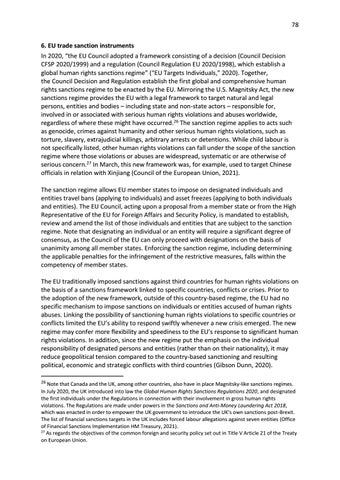78 6. EU trade sanction instruments In 2020, “the EU Council adopted a framework consisting of a decision (Council Decision CFSP 2020/1999) and a regulation (Council Regulation EU 2020/1998), which establish a global human rights sanctions regime” (“EU Targets Individuals,” 2020). Together, the Council Decision and Regulation establish the first global and comprehensive human rights sanctions regime to be enacted by the EU. Mirroring the U.S. Magnitsky Act, the new sanctions regime provides the EU with a legal framework to target natural and legal persons, entities and bodies – including state and non-state actors – responsible for, involved in or associated with serious human rights violations and abuses worldwide, regardless of where these might have occurred.26 The sanction regime applies to acts such as genocide, crimes against humanity and other serious human rights violations, such as torture, slavery, extrajudicial killings, arbitrary arrests or detentions. While child labour is not specifically listed, other human rights violations can fall under the scope of the sanction regime where those violations or abuses are widespread, systematic or are otherwise of serious concern.27 In March, this new framework was, for example, used to target Chinese officials in relation with Xinjiang (Council of the European Union, 2021). The sanction regime allows EU member states to impose on designated individuals and entities travel bans (applying to individuals) and asset freezes (applying to both individuals and entities). The EU Council, acting upon a proposal from a member state or from the High Representative of the EU for Foreign Affairs and Security Policy, is mandated to establish, review and amend the list of those individuals and entities that are subject to the sanction regime. Note that designating an individual or an entity will require a significant degree of consensus, as the Council of the EU can only proceed with designations on the basis of unanimity among all member states. Enforcing the sanction regime, including determining the applicable penalties for the infringement of the restrictive measures, falls within the competency of member states. The EU traditionally imposed sanctions against third countries for human rights violations on the basis of a sanctions framework linked to specific countries, conflicts or crises. Prior to the adoption of the new framework, outside of this country-based regime, the EU had no specific mechanism to impose sanctions on individuals or entities accused of human rights abuses. Linking the possibility of sanctioning human rights violations to specific countries or conflicts limited the EU’s ability to respond swiftly whenever a new crisis emerged. The new regime may confer more flexibility and speediness to the EU’s response to significant human rights violations. In addition, since the new regime put the emphasis on the individual responsibility of designated persons and entities (rather than on their nationality), it may reduce geopolitical tension compared to the country-based sanctioning and resulting political, economic and strategic conflicts with third countries (Gibson Dunn, 2020). 26 Note that Canada and the UK, among other countries, also have
in place Magnitsky-like sanctions regimes. In July 2020, the UK introduced into law the Global Human Rights Sanctions Regulations 2020, and designated the first individuals under the Regulations in connection with their involvement in gross human rights violations. The Regulations are made under powers in the Sanctions and Anti-Money Laundering Act 2018, which was enacted in order to empower the UK government to introduce the UK’s own sanctions post-Brexit. The list of financial sanctions targets in the UK includes forced labour allegations against seven entities (Office of Financial Sanctions Implementation HM Treasury, 2021). 27 As regards the objectives of the common foreign and security policy set out in Title V Article 21 of the Treaty on European Union.













